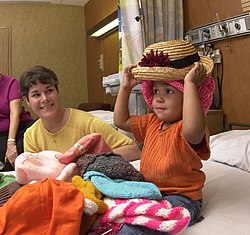| ICCC Classification | Information | Signs and Symptoms |
|---|
| I. Leukemias, Myeloproliferative And Myelodysplastic Diseases |
|---|
| (a) Lymphoid leukemias | This is the most common type of cancer during childhood, and acute lymphoblastic leukemia (ALL) is most common in children. [14] ALL usually develops in children between the ages of 1 and 10 (it could occur at any age). This type of cancer is more prevalent in males and white people. [15] Diagnosis is frequently delayed due to nonspecific early symptoms. | |
| (b) Acute myeloid leukemias |
| (c) Chronic myeloproliferative diseases |
| (d) Myelodysplastic syndrome and other myeloproliferative diseases |
| (e) Unspecified and other specified leukemias |
| II. Lymphomas and reticuloendothelial neoplasms |
|---|
| (a) Hodgkin lymphomas | The likelihood of developing Hodgkin Lymphoma increases during childhood and it peaks in adolescence. [16] [17] It is often associated with Epstein-Barr virus infection. [18] | - Painless mass in the neck
- Persistent cough secondary to a mediastinal mass
- Less commonly: splenomegaly or enlarged axillary or inguinal lymph nodes
- Intermittent fever
- Drenching night sweats
- Loss of greater than 10 percent of total body weight
- Anorexia
- Fatigue
- Pruritus
- Persistent painless mass
|
| (b) Non-Hodgkin lymphomas (except Burkitt lymphoma) | Non-Hodgkin's lymphoma is more common in older children, and it is less prevalent than Hodgkin's disease. [19] | If the abdomen is affected If mediastinum is affected If head and neck masses are affected - Palpable mass
- Cranial nerve palsies
- Nasal obstruction
|
| (c) Burkitt lymphoma |
| (d) Miscellaneous lymphoreticular neoplasms |
| (e) Unspecified lymphomas |
| III. CNS and Miscellaneous Intracranial and Intraspinal Neoplasms |
|---|
| (a) Ependymomas and choroid plexus tumor | CNS tumors are the second most common malignancy diagnosed during childhood, and they are the leading cause of death from cancer in children. [21] [22] | |
| (b) Astrocytomas |
| (c) Intracranial and intraspinal embryonal tumors |
| (d) Other gliomas |
| (e) Other specified intracranial and intraspinal neoplasms |
| (f) Unspecified intracranial and intraspinal neoplasms |
| IV. Neuroblastoma And Other Peripheral Nervous Cell Tumors |
|---|
| (a) Neuroblastoma and ganglioneuroblastoma | Neuroblastomas are the most common extracranial solid tumor in children. [23] | - Dysfunction of the location of the primary tumor
- Anorexia
- Abdominal pain
- Distention
|
| (b) Other peripheral nervous cell tumors |
| V. Retinoblastoma |
|---|
| Retinoblastoma | Retinoblastomas typically affect children under 3 years old. [24] [25] Most children in resource-rich areas survive but they may lose vision in the affected eye. [26] [27] | |
| VI. Renal Tumors |
|---|
| (a) Nephroblastoma and other non-epithelial renal tumors | Nephroblastoma, also known as Wilm's tumor, represents the majority of cases of renal tumors in children. [28] | |
| (b) Renal carcinomas |
| (c) Unspecified malignant renal tumors |
| VII. Hepatic Tumors |
|---|
| (a) Hepatoblastoma and mesenchymal tumors of liver | Hepatic tumors are relatively rare in children, but are most commonly hepatoblastomas if they do occur. [29] | |
| (b) Hepatic carcinomas |
| (c) Unspecified malignant hepatic tumors |
| VIII. Malignant Bone Tumors |
|---|
| (a) Osteosarcomas | Bone tumors in children typically arise in adolescence. These typically have a good prognosis with chemotherapy, radiation, and surgery if necessary. [30] | |
| (b) Chondrosarcomas |
| (c) Ewing tumor and related sarcomas of bone |
| (d) Other specified malignant bone tumors |
| (e) Unspecified malignant bone tumors |
| IX. Soft Tissue And Other Extraosseous Sarcomas |
|---|
| (a) Rhabdomyosarcomas | Soft tissue sarcomas can form anywhere in the body as a cancer of the body's supporting tissues, including fat, muscle, and blood vessels. [31] | - Localized mass
- Swelling or pain
- Limited range of motion
- Redness or warmth
- Skin changes (ulceration, discoloration)
|
| (b) Fibrosarcomas, peripheral nerve sheath tumors and other fibrous neoplasms |
| (c) Kaposi sarcoma |
| (d) Other specified soft tissue sarcomas |
| (e) Unspecified soft tissue sarcomas |
| X. Germ Cell Tumors, Trophoblastic Tumors And Neoplasms Of Gonads |
|---|
| (a) Intracranial and intraspinal germ cell tumors | These tumors arise from cells that eventually form sperm or eggs. They are often found in the gonads, but can travel to other parts of the body. [32] | |
| (b) Malignant extracranial and extragonadal germ cell tumors |
| (c) Malignant gonadal germ cell tumors |
| (d) Gonadal carcinomas |
| (e) Other and unspecified malignant gonadal tumors |
| XI. Other Malignant Epithelial Neoplasms And Malignant Melanomas |
|---|
| (a) Adrenocortical carcinomas | These tumors are classified as functioning or non-functioning, depending on whether they produce adrenocortical hormone. [33] | |
| (b) Thyroid carcinomas | Thyroid cancers include four main types: papillary, follicular, medullary, and anaplastic. Of these, papillary is the most common in children and anaplastic is rarely seen. [34] | |
| (c) Nasopharyngeal carcinomas | This is a rare cancer which forms in the back of the nasal cavity in the throat. It is associated with Epstein-Barr virus infection. [35] | |
| (d) Malignant melanomas | Skin cancers are rare in children due to less UV exposure, though may be seen in children with a family history of skin cancer or a genetic condition such as xeroderma pigmentosum. [36] | - Skin changes (discoloration, ulceration, etc)
- Mole or freckle which is growing or changing color
- Pruritus
|
| (e) Skin carcinomas |
| (f) Other and unspecified carcinomas |
| XII. Other And Unspecified Malignant Neoplasms |
|---|
| (a) Other specified malignant tumors |
| (b) Other unspecified malignant tumors |


